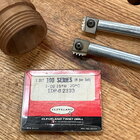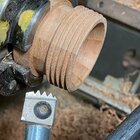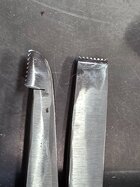I watched a hand thread chasing demo today at a local symposium and would like to give it a try. The only tools mentioned were the Sorby set and the Carter & Son Mahoney thread chaser. Are there others available I should look into? Do you have any recommendations for the Sorby, C&S or other brands? I know it's going to take a lot of practice and choice of woods to get consistent results, but I'd like to start out with whatever tools will make the learning curve as gentle as possible.
-
December 2025 Turning Challenge: Single Tree! (click here for details) -
Congratulations to Bob Henrickson, People's Choice in the November 2025 Turning Challenge (click here for details) -
Congratulations to Steven Gordon for "Dropped Ice Cream Cone" being selected as Turning of the Week for December 8, 2025 (click here for details) -
Welcome new registering member. Your username must be your real First and Last name (for example: John Doe). "Screen names" and "handles" are not allowed and your registration will be deleted if you don't use your real name. Also, do not use all caps nor all lower case.
You are using an out of date browser. It may not display this or other websites correctly.
You should upgrade or use an alternative browser.
You should upgrade or use an alternative browser.
Available hand thread chasing tools
- Thread starter Ric Williams
- Start date
- Joined
- Feb 6, 2010
- Messages
- 3,454
- Likes
- 2,522
- Location
- Brandon, MS
- Website
- threeringswoodshop.square.site
Iles makes one but from over the pond also. I think most I have seen use Sorby
Jim McLain
Artist
john lucas
AAW Forum Expert
Mark St Leger may still sell them. Havent talked to him in a while. I wrote an article on making your own but you need some some skills with a file and a huge amount of patience. Mark's and Mahoneys are nice because both tools are the same shaft so you never lose the mate. I bought 14 antique chasing tools from a tool dealer at a flea mkt. But only got 3 matching sets. Someday I will make the mate.
Both Hamlet and Crown make them, too.
My favorite is the Mayes and Warwick set from the Woodturners catalog. The sorby set I found the handles way too long.
Thanks Emiliano, but it looks like they're no longer available from them. Google didn't list any dealers for them.
Hughie, is that a regular bottom tap with 2 sides ground off?
MikeHughie, is that a regular bottom tap with 2 sides ground off?
No , its screw cut 20mm dia 17tpi made out of 1040 steel hardened and tempered, hollow ground and works just fine. I would have used HSS but really dont have any way to heat-treat it.
Plus I didnt like the idea of having multiple tools for the same task ,I suppose it makes sense if you're selling tools. But for me it was an added expense and not necessary. I have made a few for others since this and it has proved to be a good tool. I am putting all these sort of ideas in a e-book or similar, hopefully it will be found useful in the woody community.
john lucas
AAW Forum Expert
I have made them by brazing taps onto flat stock.
Hey so I love ideas like this. I'm still in the beginning stages of woodturning tool making. PVC with aluminum inserts for handles is my current project.Mike
No , its screw cut 20mm dia 17tpi made out of 1040 steel hardened and tempered, hollow ground and works just fine. I would have used HSS but really dont have any way to heat-treat it.
Plus I didnt like the idea of having multiple tools for the same task ,I suppose it makes sense if you're selling tools. But for me it was an added expense and not necessary. I have made a few for others since this and it has proved to be a good tool. I am putting all these sort of ideas in a e-book or similar, hopefully it will be found useful in the woody community.
I've been looking at buying some thread chasers but they're all so expensive. I doubt I have the machinery capable of making one of these but I'm wondering if you ever created your ebook?
- Joined
- Feb 28, 2021
- Messages
- 1,770
- Likes
- 1,582
- Location
- Roulette, PA
- Website
- www.reallyruralwoodworks.com
Well, in theory you could make your own thread chasers from an ordinary thread tap (1/4-20 to make 20 TPI threads, 38-16 to make 16 TPI threads, and so on) Only trick I think would be modifying the trailing side of the tap (ruining it for any other use) to cut your external threads (or you'd have to do them with lathe in reverse) but I'd imagine it'd be entirely do-able. (Hint for less grinding and stuff, you might look for a bottoming tap - they are to "finish off" a blind threaded hole where the regular plain taps can't get to the bottom (because of the taper and point to the threads to get threads started) Have not tried it myself (I bought a C&S 16 TPI chaser double ended, but I might try it to make a 12,10, or 8 TPI chaser if I get around to finding a decent deal on a bottoming tap)I've been looking at buying some thread chasers but they're all so expensive. I doubt I have the machinery capable of making one of these
This is why I love forums haha. Thank you! I'm going to do a deep dive later. Thank you again.Well, in theory you could make your own thread chasers from an ordinary thread tap (1/4-20 to make 20 TPI threads, 38-16 to make 16 TPI threads, and so on) Only trick I think would be modifying the trailing side of the tap (ruining it for any other use) to cut your external threads (or you'd have to do them with lathe in reverse) but I'd imagine it'd be entirely do-able. (Hint for less grinding and stuff, you might look for a bottoming tap - they are to "finish off" a blind threaded hole where the regular plain taps can't get to the bottom (because of the taper and point to the threads to get threads started) Have not tried it myself (I bought a C&S 16 TPI chaser double ended, but I might try it to make a 12,10, or 8 TPI chaser if I get around to finding a decent deal on a bottoming tap)
john lucas
AAW Forum Expert
Ive also made chasers simply by filing. I took a camera repair course many years ago and I'm really good with a file. However all it takes is a good magnifier and patience.
Brian, could you explain what you mean about needing to run the lathe in reverse? Not sure i understand. Thanks!Well, in theory you could make your own thread chasers from an ordinary thread tap (1/4-20 to make 20 TPI threads, 38-16 to make 16 TPI threads, and so on) Only trick I think would be modifying the trailing side of the tap (ruining it for any other use) to cut your external threads (or you'd have to do them with lathe in reverse) but I'd imagine it'd be entirely do-able. (Hint for less grinding and stuff, you might look for a bottoming tap - they are to "finish off" a blind threaded hole where the regular plain taps can't get to the bottom (because of the taper and point to the threads to get threads started) Have not tried it myself (I bought a C&S 16 TPI chaser double ended, but I might try it to make a 12,10, or 8 TPI chaser if I get around to finding a decent deal on a bottoming tap)
I learned how to chase threads some years ago with standard Sorby tools. After learning, I wanted to try coarser threads than what I could make with Sorby tools so I went down this rabbit hole.
Old machine shops had something call a "screw machine" which made threads with different size cutter bits. I found the bits work great for chasing threads. The bits can often be found on eBay for 10-20 dollars in a package of four or five. Do a search on eBay for "Cleveland Thread Chasers".
After getting the bits get a piece of cold rolled at the hardware store and file a seat for the chaser. Drill and tap a hole to hold the chaser in place. File a flat on the other side so it sits on the toolrest. (full disclosure, I use a Bridgeport milling machine instead of a file)
Pictured is a 8 TPI set along with a test piece. I have several different sizes of the chasers that I swap around up to 16 TPI.


Old machine shops had something call a "screw machine" which made threads with different size cutter bits. I found the bits work great for chasing threads. The bits can often be found on eBay for 10-20 dollars in a package of four or five. Do a search on eBay for "Cleveland Thread Chasers".
After getting the bits get a piece of cold rolled at the hardware store and file a seat for the chaser. Drill and tap a hole to hold the chaser in place. File a flat on the other side so it sits on the toolrest. (full disclosure, I use a Bridgeport milling machine instead of a file)
Pictured is a 8 TPI set along with a test piece. I have several different sizes of the chasers that I swap around up to 16 TPI.


Ric,I watched a hand thread chasing demo today at a local symposium and would like to give it a try. The only tools mentioned were the Sorby set and the Carter & Son Mahoney thread chaser. Are there others available I should look into? Do you have any recommendations for the Sorby, C&S or other brands? I know it's going to take a lot of practice and choice of woods to get consistent results, but I'd like to start out with whatever tools will make the learning curve as gentle as possible.
It's very simple and inexpensive to make chasing tools. I have been doing so for over 40 years and they all still work as well as the big named tools. Supplies needed; a piece of high carbon steel, a torch, a tap, hard maple, saw, clamp, and quenching liquid. If you're interested you can send a direct message. This could be a club / group project.
- Joined
- Feb 28, 2021
- Messages
- 1,770
- Likes
- 1,582
- Location
- Roulette, PA
- Website
- www.reallyruralwoodworks.com
Direction of the cutting edge of a standard tap - if you have one chucked into a handle (straight line in) then the cutting edge of the tap's "teeth" closest to you will be facing up and thus would work fine for internal threads (the female) but to cut the external threads, you're applying the trailing (non-cutting) edge of the tap's teeth to the wood , thus to get the cutting edge of the tap's teeth into the wood for external (male) threads, you either have to spin the work piece in reverse, or you'll have to modify the tap to put a cutting edge (as in like a scraper, which threading tools are) on the trailing side of the "teeth"Brian, could you explain what you mean about needing to run the lathe in reverse? Not sure i understand. Thanks!
If you're familiar with a standard threading tap, and think on it a bit, it'll come to ya... (Edit: Or, use a left handed tap for the external threads but then threads may be going the wrong way?)
john lucas
AAW Forum Expert
That's nice work. I assume they are tig welded? I am going to try silver brazing.Thread chasers I've made by welding taps to steel stock.
john lucas
AAW Forum Expert
Ive done some by brazing and made other tools by silver soldering hss to tge shank.
Wood is somewhat forgiving of improperly made hand threading chasers.. The idea of adapting taps and chasers designed for metal cutting gets a bit complicated by the lead angle of the thread form in the tool. This can be seen by trying the tool in soft aluminum, if the lead angle is not correct it won't work well at all but might do an almost acceptable job in wood. For instance, a metal threading chaser designed to cut a 1/4"-20 thread will not also cut a 2"-20 thread because of significant difference in thread lead angle (yes, there are threads such as that, we called them microscope threads, fine pitch with relatively large diameter). I realize this can get a bit confusing.
A properly made hand chaser can be seen in how easily it cuts. And I suspect a good many times an improperly homemade hand chaser not performing well will more often be blamed on the wood.
No idea how much hand chasers cost but it might be false economy to try saving a few bucks by making your own unless you have an understanding about the tool's geometry.
A properly made hand chaser can be seen in how easily it cuts. And I suspect a good many times an improperly homemade hand chaser not performing well will more often be blamed on the wood.
No idea how much hand chasers cost but it might be false economy to try saving a few bucks by making your own unless you have an understanding about the tool's geometry.


